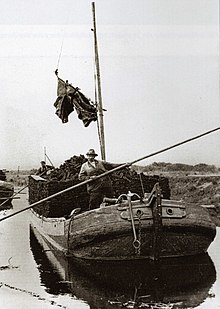Tom Wörden (shipyard)
Klaus Wilhelm tom Wörden took over an existing shipyard in 1903, began a new phase in his life as a captain shipowner in 1911 with the last new building and thus laid the foundation for a shipping company that celebrated its centenary as a group of companies in 2011.

Development of the shipyard
Klaus Wilhelm tom Wörden completed an apprenticeship as a ship carpenter in Bremervörde and worked here as a journeyman for several years. After his marine time in Wilhelmshaven, he worked as a master craftsman in Otterndorf and leased a small shipyard in Niederstricherdeich. Then in 1903 he took over the shipyard in Graepel, founded by Johann Steffens in 1875, also on the Oste . Depending on the source, you can find the spelling W. tom Wörden, tom Woerden or thom Worden.
From 1875 to 1911, a total of around 25 small ships, Ewer , Galeassen and three-masted gaff schooners were built at this shipyard . Most of the ships at this shipyard were measured below 50 BT, the largest ships were measured up to 120 BT. To J. Jungclaus ( Hechthausen ) was established by Hans one of the larger three-masted gaff schooner delivered with 80 BT. The largest three-masted gaff schooner with 116 BT, christened "Wilhelm", was built by Klaus Wilhelm tom Wörden for himself. It was the shipyard's last ship, it was put into service on May 20, 1911 and thus marks the change in the shipyard to the shipping company.
From shipyard owner to shipowner
The shipyard was closed in 1911 and the shipyard owner Wilhelm tom Wörden (1875–1944) began a new phase of life as a shipowner with the last ship built at the shipyard. The shipping area was the coastal voyage in the area of the North Sea and the Baltic Sea, initially wood and general cargo were mainly transported. Initially, the Wilhelm was under the command of an employed captain, after acquiring the captain's license in 1918, the captain shipowner Wilhelm tom Wörden took over command of the Wilhelm himself. The captain shipowner was successful and today Klaus tom Wörden is the fourth generation to head a family company ( shipping company tom Wörden ), which has since developed into a group of companies with 350 employees and operates 35 ships that have become much too big for the Oste.
River and coastal trip
Graepel is located directly on the Oste, alongside Bremervörde it played an important role in this region as a port and especially as a shipyard location for around 200 years. In addition to two small new shipyards (Barthold Siems and Johann Steffens), Graepel had two small repair yards and around 1900 18 shipowners were based here. The ships built by Graepel shipyards were mainly delivered to the skippers in the vicinity as far as Hamburg and Cuxhaven , who mainly drove as owners. The smaller ships were mainly used in river shipping to Hamburg, Bremen or Bremervörde . At this time, peat shipping played a major role for the little sailors, especially in summer. The larger ships of these shipyards as well as those of tom Wörden were also used in coastal traffic to England.
The Oste, a tributary of the Elbe , was navigable as far as Bremervörde at the time and a large part of the movement of goods, from everyday consumer goods to building materials, was transported by ship. The return freight was peat in particular , but also wood, glass, wool and wax as well as agricultural products. Around 1850, around 700 ships sailed the Oste from Bremervörde to the mouth of the Elbe every year, so the ports and especially the Ostewerften played an important role at this time. With the construction of roads and rails, the importance decreased, and after the construction of the Ostebrücke in Hechthausen, sailing ships could no longer reach Bremervörde. Today Graepel has a very small port and a ferry across the river.
literature
- 100 years of shipping company tom Wörden, chronicle, text Ulrike Peters, Bremen o. J.